The Moon, the Earth, the Cosmos
The wanderers stopped and asked a farmer driving by in his wagon what kind of illumination lit up the sky. “It is the moon,” he answered. “Our mayor bought it for three Talers and hung it on the oak tree. Every day he must pour in oil and keep it clean so that it always burns brightly. In exchange we pay him one taler every week.”
When the farmer had driven away one of the fellows said “We could use this lamp. At home we have an oak tree that is just as big and we could hang it from there. What joy there will be when we don’t have to stumble around in the darkness!” The second fellow said “You know what? Let’s fetch a horse and wagon and take the moon away. They can buy another one here.” The third fellow said “I am a good climber. I can bring it down.” The fourth brought his horse and wagon and the third fellow climbed the tree, drilled a hole in the moon, slipped a string through the hole and lowered it to the ground. When the shining ball lay in the wagon, they covered it with a cloth so that no one would discover their theft. Happily they brought it to their country where they hung it on the bough of a giant oak. Old and young alike rejoiced at the illumination that the new lamp spread over all the fields, rooms and chambers. The gnomes came out of their caves and the elves in their red jackets danced a roundelay on the meadow.
The four chaps took care of the moon with oil, cleaned the wick and in exchange received one taler weekly. But when they became old men, one fell ill and knew his end was near. He ordered that the quarter of the moon that belonged to him should be laid with him in his grave. When he died, the mayor climbed the tree and with the hedge clippers cut down a quarter of the moon and laid it in the coffin. The light of the moon was now diminished, but not by much. When the second fellow died, his quarter was placed in his grave and the light decreased. It became even weaker after the death of the third fellow, who likewise took away his portion. When the fourth man was carried to his grave, the black night returned. When people went out at night without a lantern, they stumbled into each other and bumped their heads.
When the four parts of the moon were reunited in the underworld where darkness had always reigned, the dead became uneasy and awoke from their sleep. They were amazed at what they could see. Their eyes had become so weak that they could not bear the light of the sun. They got up, rejoiced and began their old lives all over again. Some went out dancing, others went to the pubs, where they drank wine, got drunk, raged and bickered, and finally lifted their bludgeons and beat each other. The pandemonium became more and more bitter and finally rose to the heavens.
St. Peter, who guarded heaven’s gate, believed the underworld was in revolt and called out to the heavenly host. “Depose the evil one,” he cried for “he and his disciples shall enter the place of the blessed.” But they never arrived so he mounted his steed and rode out beyond heaven’s gate to the underworld. There he calmed the dead, commanded them back into their graves and took the moon away, which he then hung up in the heavens.

